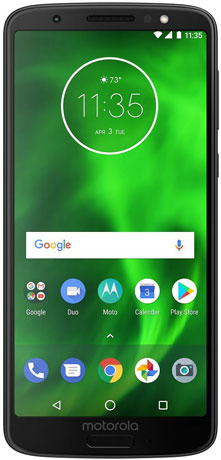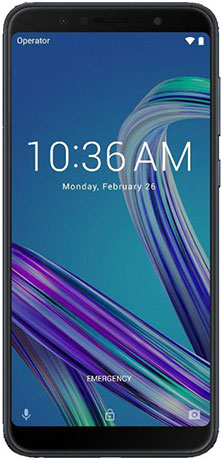Compare Moto G6 (3 GB) vs Asus ZenFone Max Pro M1 (4 GB)
Rank :
#2
|
Our Score
74
Out of 100
|
|
|
|
|
|
|
|
|
|
|
|
|
|
|
|
|
|
|
Rank :
#1
|
Our Score
80
Out of 100
|
|
|
|
|
|
|
|
|
|
|
|
|
|
|
|
|
|
|
| Performance |
It has around 49% better Performance
|
|
| Rear Camera |
It has around 10% better Rear Camera quality
|
|
| Front Camera |
It has around 25% better Front Camera quality
|
|
| Design |
It has around 5% better Design
|
|
| Display |
Almost similar Display quality
|
Almost similar Display quality
|
| Battery |
It has around 39% better Battery backup
|
|
| Features |
It has around 25% more Features
|
|
| Connectivity |
It has around 25% more Connectivity options
|
|
| Value for Money |
It has around 47% more Value for Money
|
|
| User Experience |
It has around 20% better User Experience
|
| RAM |
It has 1 GB (25%) more RAM
|
|
| Screen Size |
It has 0.29 inches (5%) bigger Screen
|
|
| Storage |
It has 32 GB (50%) more Internal Storage
|
|
| Thickness |
It has 0.16 mm (2%) Slimmer body
|
|
| Weight |
It is 13 grams (7%) lighter
|
|
| Age |
It is 42 days younger
|
Suitable for? |
Moto G6 (3 GB) |
Asus ZenFone Max Pro M1 (4 GB) |
| Heavy Users | ||
| Normal Day to Day Users | ||
| Heavy Gamers | ||
| Moderate Gamers | ||
| Camera Lovers | ||
| Selfie Lovers | ||
| Multimedia Consumption |
Full Specifications |
Moto G6 (3 GB) |
Asus ZenFone Max Pro M1 (4 GB) |
| Phone Name(s) | Moto G6 | Asus Zenfone Max Pro M1 |
| Manufacturer | Motorola | Asus |
| Announced | April 2018 | April 2018 |
| Released | June 2018 | May 2018 |
| Build | Narrow Bezel, Front/Back Glass, Metal body | Slim bezel, Metal unibody design |
| Colors |
Indigo Black
|
Titanium Grey
Black
|
| Dimensions | 154.5 × 72.4 × 8.3 mm | 159 x 76 x 8.46 mm |
| Weight | 167 grams | 180 grams |
| Buttons | On-screen navigation buttons, Power Button, Volume Rocker | On-screen navigation buttons, Power button, Volume rocker |
| Screen Size | 5.7 inches | 5.99 inches |
| Display Type | IPS LCD | IPS LCD FullView display |
| Resolution | Full HD+ (2160 x 1080 pixels) | Full HD+ (2160 x 1080 pixels) |
| Pixel Density | 424 pixels per inch (PPI) | 402 pixels per inch (PPI) |
| Aspect Ratio | 18:9 aspect ratio | 18:9 aspect ratio |
| Display Area | 75.4% screen-to-body ratio | 77% screen-to-body ratio |
| Protection | Corning Gorilla Glass 3 | 2.5D curved glass |
| Touchscreen | Yes, Capacitive, Multitouch | Yes, Capacitive, Multitouch |
| Processor | 1.8 GHz Octa-Core Qualcomm Snapdragon 450 | 1.8 GHz Kyro Octa-Core Qualcomm Snapdragon 636 |
| RAM | 3 GB | 4 GB |
| GPU | Adreno 506 | Adreno 509 |
| Internal | 32 GB | 64 GB |
| External | microSD up to 256 GB | microSD up to 2 TB |
| USB OTG | Yes | Yes |
| OS | Android 8.0 Oreo | Android 8.1 Oreo |
| User Interface | Almost Stock Android UI | ZenUI with almost Stock Android |
| Features | Moto Actions - Quick screenshot, One button nav, Chop twice for torch, Twist for quick capture, Swipe to shrink screen, Pick up to stop ringing, Flip for do not disturb | Promised updates to Android P and Android Q when released |
| Rear Camera | 12 MP (f/1.8) + 5 MP (f/2.2) Dual cameras with Dual-tone LED flash | 13 MP + 5 MP Dual Cameras with LED flash |
| Details | Dual Autofocus Pixel technology, Time-lapse, Slow motion, Landmark recognition, Object recognition, Text scanner, Portrait mode, Spot colour, Face filters, Panorama, Manual mode | Primary sensor: f/2.2 aperture, 1.12 μm pixel size, PDAF, Auto, HDR, Portrait mode, Scene mode, Panorama, Time-lapse, Beauty Secondary sensor: f/2.4 aperture, 1.12 μm pixel size, Bokeh effect |
| Video Recording | Up to 1080p @60fps, Timelapse video, Slow motion | 2160p @30fps, 1080p @30fps |
| Front Camera | 16 MP camera with LED flash | 8 MP camera with LED flash |
| Details | f/2.2 aperture, Face filters, Group selfie mode, Beautification mode, Manual mode | f/2.2 aperture, 1.0 μm pixel size, Bokeh mode, HDR, Beauty shot |
| Video Recording | Up to 1080p @30fps, Timelapse video, Slow motion | 1080p @30fps |
| SIM | Dual SIM (dedicated slots) | Dual SIM (dedicated slots) |
| SIM Size | Nano SIM | Nano SIM |
| Capacity | 3000 mAh Li-Ion battery | 5000 mAh Li-Po battery |
| Fast Charging | Yes, Turbo Charging | No, 5V/2A 10W Charging |
| Wireless Charging | No | No |
| Removable Battery | No | No |
| Security | Fingerprint Scanner, Face Unlock | Fingerprint Scanner, Facial Unlock |
| Sensors | Accelerometer, Gyroscope, Ambient Light Sensor, Proximity Sensor, Magnetometer, Ultrasonic | Accelerator, E-Compass, Proximity sensor, Ambient light sensor, Gyroscope |
| Wi-Fi | 802.11 a/b/g/n/ac, 2.4 GHz + 5 GHz dual-band, Wi-Fi Direct, Wi-Fi Hotspot | 802.11 b/g/n, Wi-Fi Direct, Wi-Fi Hotspot |
| Bluetooth | v4.2, EDR & BLE | v4.2, A2DP, LE |
| Location | GPS, A-GPS, GLONASS, BeiDou | GPS, A-GPS, GLONASS, BDS |
| USB Type | USB Type-C | microUSB 2.0 |
| FM Radio | Yes | Yes |
| NFC | No | No |
| Infrared | No | No |
| Speakers | Yes, Earpiece doubles up as loud speaker, Dolby Audio | Yes, 5-magnet loudspeaker with NXP Smart AMP |
| 3.5mm Headphone Jack | Yes | Yes |
| Microphone | One primary microphone and dedicated microphone for Active noise cancellation | One primary microphone and one dedicated microphone for Active noise cancellation |
| Cellular Networks | 2G, 3G, 4G / VoLTE | 2G, 3G, 4G / VoLTE |
| 2G Bands | GSM B2, B3, B5, B8 | GSM 850/ 900/ 1800/ 1900 MHz |
| 3G Bands | UMTS B1, B2, B5, B8, B19 | HSDPA 800/ 850/ 900/ 1900/ 2100 |
| 4G Bands | LTE B1 (2100) B2 (1900) B3 (1800) B5 (850) B7 (2600) B8 (900) B18 B19 (Japan 850) B26 (850+) B28 (700 APT) B38 (TD2600) B40 (TD2300) B41 (2535M to 2655M) | FDD LTE 1(2100)/ 3(1800)/ 5(850)/ 7(2600)/ 8(900)/ 20(800) TDD LTE 40(2300) |
| Speed | - | HSPA 42.2/5.76 Mbps, LTE Cat4 150/50 Mbps |
| Head | - | - |
| Body | - | - |
| Notification LED | Yes | Yes |
| Water Resistance | P2i water-repellent nano coating | No |
| What's in the box? | Asus ZenFone Max Pro M1, Micro-USB cable, Max-Box, SIM Ejector pin, USB power adapter, Documentation (user guide, warranty card) |


 1.8 GHz Octa-Core Snapdragon 450
1.8 GHz Octa-Core Snapdragon 450
 3 GB RAM
3 GB RAM
 Android 8.0
Android 8.0  5.7 inch (FHD+)
5.7 inch (FHD+)  Dual Sim
Dual Sim
 12,5MP + 16MP
12,5MP + 16MP
 3,000 mAh
3,000 mAh
 32 GB Internal
32 GB Internal
 256 GB microSD
256 GB microSD
 4G VoLTE, Face Unlock, Fingerprint
4G VoLTE, Face Unlock, Fingerprint 